| Authors: | Ángeles G. Mayor, V Ramón Vallejo, Susana Bautista with Peter de Ruiter, Lia Hemerik, Violette Geissen, Jaap Bloem, Jacob Kéizer, Óscar González-Pelayo, Ana Isabel Machado, Sílvia Faria, Ana Vasques, Luna Morcillo, Rosario López-Poma, Azucena Camacho, Anna Urgeghe, Diana Turrión, Christel van Eck, Martinho Martins, Paula Maia, Alejandro Valdecantos, Jaime Baeza, Joan Llovet, David Fuentes, Giovanni Quaranta, Rosanna Salvia, Velia De Paola, Ioannis N. Daliakopoulos, Ioanna Panagea, Ioannis K. Tsanis, Michalakis Christoforou, Christiana Papoutsa, Dimitris Tsaltas, Kostas Andreou, Kyriakos Themistokleous, Giorgos Papadavid and Diofantos Hatzimitsis. |
| Editor: | Jane Brandt |
| Source document: | Mayor et al. (2017) Identification of critical changes preceding catastrophic shifts: ecosystems affeced by increasing grazing intensity and severe drought. CASCADE Project Deliverable 3.1b |
1. Study sites
The observational and manipulative experiments were conducted in the six CASCADE study sites, which are all located in southern Europe. Two are stressed by fire: Várzea in North-Central Portugal and Ayora in Eastern Spain, and four by grazing: Albatera-Santomera in Eastern Spain, Castelsaraceno in Southern Italy, Messara in Southern Crete and Randi in Southern Cyprus.
For general descriptions of the study sites including information on geography, soils, climate, land use, degradation drivers, socioeconomic status and evolution of vegetation see
»Várzea Portugal: Description of site and main causes of degradation
»Albatera, Spain: Description of site and main causes of degradation
»Ayora, Spain: Description of site and main causes of degradation
»Castelsaraceno, Italy: Description of site and main causes of degradation
»Messara, Greece: Description of site and main causes of degradation
»Randi Forest, Cyprus: Description of site and main causes of degradation
A brief summary of the study site characteristics is provided in Table 1.
Table 1. Summarized description of the study sites
| Variables | Várzea (Portugal) | Albaterra (Spain) | Ayora(Spain) | Castelsaraceno (Italy) | Messara (Greece) | Randi (Cyprus) |
| Stress factor | Fire | Grazing | Fire | Grazing | Grazing | Grazing |
| Mean annual T (ºC) | 13.4 | 18 | 14.6 | 9.1 | 17.9 | 19.5 |
| Mean annual rainfall (mm) | 1170 | 268 | 385 | 1290 | 504 | 489 |
| Elevation (m.a.s.l) | 468 - 530 | 180 – 270 | 763 - 1041 | 1764 - 1861 | 435 | 140 |
| Aspect | SSW | NE | NW | E/NE | N | NE/W |
| Soil type & bedrock | Umbrisols; Cambisols over schists | Calcisols; Cambisols over marls | Regosols over marls/ limestone | Regosols over limestone/ dolomite | Cambisols; Luvisols over marls/limestone | Calcaric Regosols over marls |
| Plant community | Pine woodland | Open shrubland | Pine woodland | Grassland | Open shrubland | Open shrubland |
2. Target species
For all six CASCADE sites, we identified the most relevant plant species to be considered as target species. The species selected were either shrubs or perennial grasses (Table 2). The selection was based on the importance of their role (abundance; functional role) in the ecosystems of study. The target species in Várzea, Pterospartum tridentatum, is a dominant shrub species in the study site, which quickly resprouts after fire and plays a critical role in the post-fire recovery of the vegetation. Rosmarinus officinalis, the target species in Ayora, represents a different post-fire regeneration strategy, a post-fire seeding shrub, which is very common in fire-prone shrublands developed in old agricultural fields in the Mediterranean. Anthyllis cytisoides and Calicotome villosa, the target species in Albatera and Randi, respectively, represent abundant palatable shrubs and therefore represent the species that are the most likely to be affected by grazing intensity. Similarly, Brachypodium rupestre and Stipa austroitalica in Castelsaraceno and in Hyparrhenia hirta Messara represent the common palatable grasses in these grazed areas.
Table 2. Selected target species
| Species | Species description |
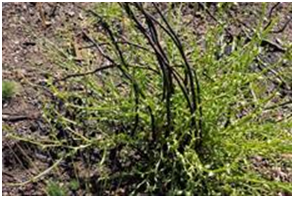 |
Name: Pterospartum tridentatum (L.) |
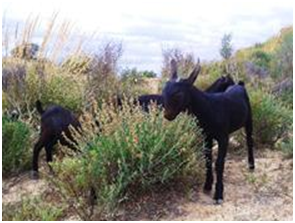 |
Name: Anthyllis cytisoides (L.) Family: Fabaceae Functional group: Subshrub Functional strategy: Drought deciduous species Site: Albatera-Santomera (Spain) |
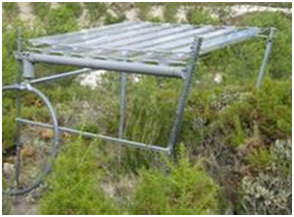 |
Name: Rosmarinus officinialis (L.) Family: Lamiaceae Functional group: Shrub Functional strategy: Seeder species Site: Ayora-Mariola (Spain) |
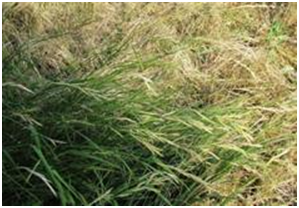 |
Name: Brachypodium rupestre (Host) Roem. & Schult. Family: Poaceae Functional group: Herb Functional strategy: Perennial grass Site: Castelsaraceno (Italy) |
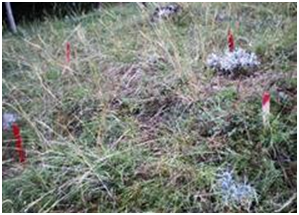 |
Name: Stipa austroitalica (Martinovský) Family: Poaceae Functional group: Tussock grass Functional strategy: Perennial grass Site: Castelsaraceno (Italy) |
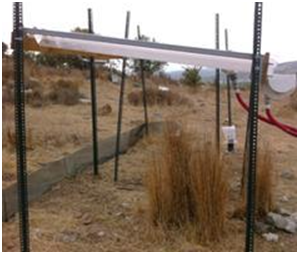 |
Name: Hyparrhenia hirta (L.) Family: Poaceae Functional group: Subshrub Functional strategy: Perennial grass Site: Messara (Crete) |
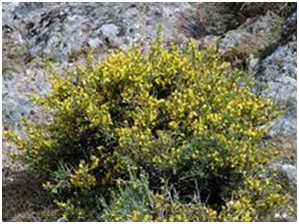 |
Name: Calicotome villosa (Poir.) Link Family: Fabaceae Functional group: Shrub Functional strategy : Drought deciduous species Site: Randi (Cyprus) |
Note: For full references to papers quoted in this article see
